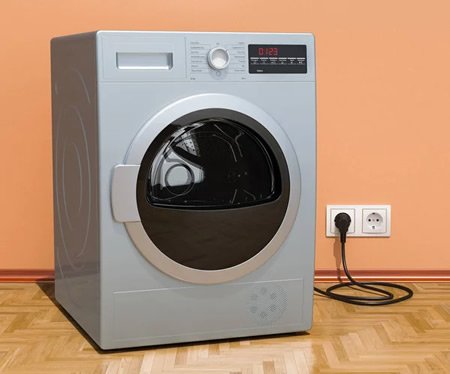Electric Dryer Outlet Installation: What Kind Of Outlet Do I Need For My Electric Dryer?

When it comes to purchasing a new electric dryer, one of the most important things to consider is the type of electric dryer wall outlet you will need. Different dryers require different electric dryer plug in outlets, and it's crucial to make sure you have the correct electric outlet for dryer before making your purchase. In this article, we will discuss the electric dryer outlet requirements, dryer plug types, and dryer outlet wiring to help you determine what kind of outlet you need for your electric dryer.
Electric Dryer Outlet Requirements
Before purchasing an electric dryer, it's important to check the outlet requirements for the specific model you are interested in. Most electric dryers require a 220 electric dryer plugs, which is different from the standard 120-volt outlet used for smaller appliances. This means that you will need a dedicated circuit for your electric dryer receptacle, as it cannot be shared with other appliances. Additionally, the outlet should be grounded and have a three-prong plug to ensure safety.
Dryer Plug Types
There are three main types of dryer plugs: 3-prong, 4-prong, and 4-prong twist-lock. The type of plug you need will depend on the age of your home and the type of outlet you have. Older homes may have a 3-prong outlet, while newer homes are required to have a 4-prong outlet for safety reasons. The 4-prong twist-lock plug is typically used for commercial dryers and is not commonly found in residential settings.
Dryer Outlet Wiring
The wiring for your electric dryer outlet is also an important factor to consider. If you have an older home with a 3-prong outlet, you may need to upgrade to a 4-prong outlet to meet current safety standards. This will require rewiring the electric dryer outlet box, which should be done by a licensed electrician Boulder. If you have a newer home with a 4-prong outlet, you may still need to check the wiring to ensure it is up to code and can handle the power requirements of your cloths dryer electric plug.
Choosing the Right Outlet
When purchasing a new electric dryer, it's important to make sure you have the correct receptacle for electric dryer to avoid any safety hazards or damage to your appliance. If you are unsure about the type of outlet for electric dryer you have or need to upgrade your outlet, it's best to consult with a licensed Boulder electrician. They can help determine the best course of action and ensure that your outlet and dryer electrical box is properly installed and wired.
Electric Dryer Outlets Explained
Electric dryers are a common household appliance, but many people may not understand the different types of clothes dryer electrical outlets and power connections that are required for them to function. In this article, we will explain the basics of electric dryer outlets and help you understand the different options available.
Types of Outlets
There are two main types of outlets used for electric dryers: the 3-prong outlet and the 4-prong outlet. The 3-prong outlet, also known as a NEMA 10-30, has been the standard for many years. It has three straight slots, with the two outer slots being angled and the middle slot being L-shaped. The 4-prong outlet, also known as a NEMA 14-30, is a newer standard that was introduced in the 1990s. It has four slots, with the two outer slots being angled and the two inner slots being L-shaped.
Power Connections
The power connection for an electric dryer is made through a dryer plug, which is inserted into the outlet and a electrical box for dryer outlet. The 3-prong dryer plug has three prongs that correspond to the three slots in the outlet. The 4-prong dryer plug has four prongs that correspond to the four slots in the outlet. The prongs on the dryer plug are different sizes, so they can only be inserted into the outlet in one direction.
Differences Between 3-Prong and 4-Prong Outlets
The main difference between the 3-prong and 4-prong outlets is the grounding wire. The 3-prong outlet does not have a grounding wire, while the 4-prong outlet has a dedicated grounding wire. This grounding wire is important for safety reasons, as it helps prevent electrical shocks. The 4-prong outlet is also more efficient, as it allows for a separate ground and neutral wire, which helps balance the electrical load.
Converting from 3-Prong to 4-Prong Outlets
If you have an older home with a 3-prong outlet, you may need to convert it to a 4-prong outlet in order to use a newer electric dryer. This process involves replacing the outlet and the dryer plug, as well as adding a grounding wire. It is recommended to hire a licensed electrician to perform this conversion, as it involves working with electricity and can be dangerous if not done correctly.
Other Considerations
When installing an electric dryer outlet, it is important to make sure it is the correct voltage for your dryer. Most electric dryers require a 240-volt outlet, while some may require a 120-volt outlet. It is also important to make sure the outlet is installed in a safe location, away from water sources and other potential hazards.
Conclusion
Electric dryer outlets may seem confusing, but understanding the different types and power connections can help you choose the right one for your home. If you are unsure about which outlet is right for your dryer, consult the manufacturer's instructions or hire a licensed Boulder CO electrician for assistance. By having the correct outlet and power connection, you can ensure your electric dryer runs safely and efficiently.
